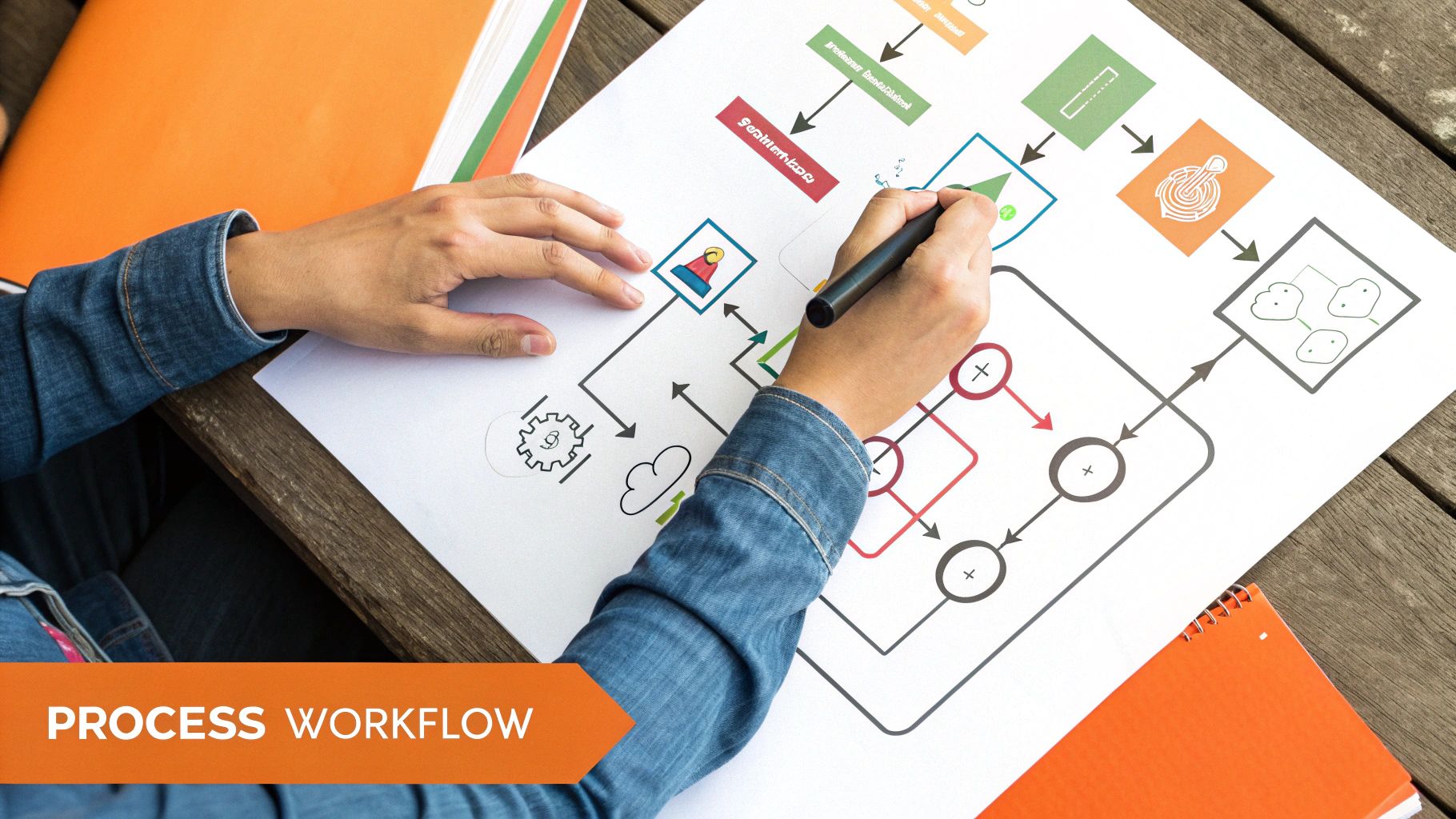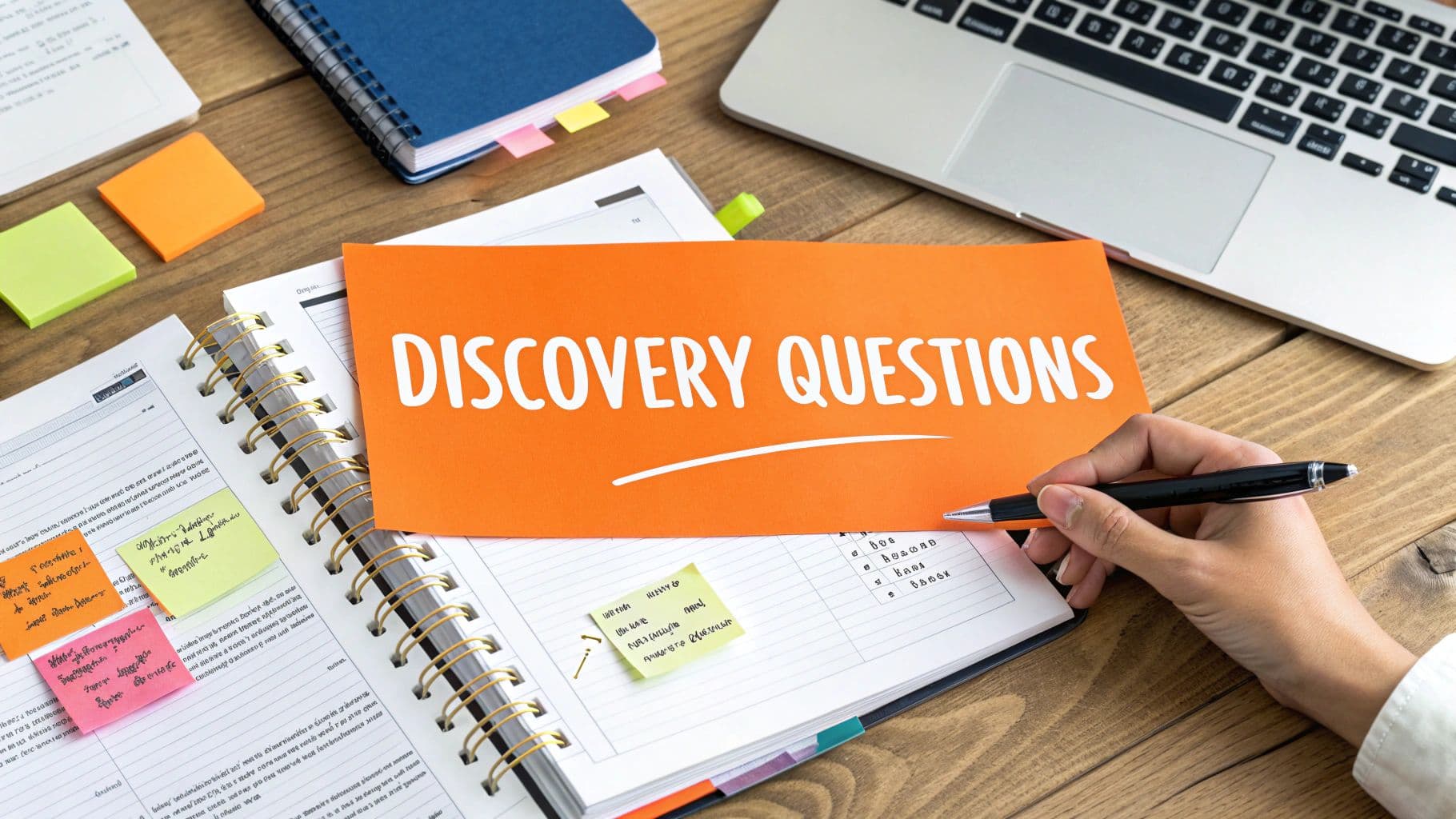The path from a brilliant idea to a successful startup is paved with conversations. Yet, the quality of these conversations determines whether you build a 'nice-to-have' gadget or an indispensable solution. Generic questions yield vague answers and false confidence. Specific, well-crafted customer discovery interview questions, however, are your most critical tool for uncovering the deep-seated problems, existing workflows, and true motivations of your target audience. They are the difference between guessing what people want and knowing what they will pay for.
This guide moves beyond theory to provide a curated list of powerful, actionable questions designed to get you past surface-level compliments and into the core of your customers' challenges. You will learn not just what to ask, but why each question works and how to interpret the answers to validate your assumptions. For indie hackers and solopreneurs looking to find these initial problems before even starting interviews, finding real user pain points is the first hurdle. Tools like ProblemSifter are invaluable here. It scours communities like Reddit to find real people discussing specific pain points, giving you a pre-validated starting point for your discovery process. By asking the right questions, you ensure the product you build is one customers are desperately waiting to use. We will explore the exact inquiries that unlock these insights.
1. Tell me about the last time you encountered this problem
This question is foundational to effective customer discovery because it shifts the conversation from hypotheticals to concrete reality. Instead of asking what a customer might do, you ask what they did. This approach, popularized by methodologies like The Mom Test, forces the interviewee to recall a specific, real-world instance of the problem you aim to solve. The goal is to uncover the raw, unfiltered details of their experience, including their actions, emotions, and the ultimate impact.

By focusing on a past event, you gather evidence of the problem's existence and severity. If a user can’t recall a specific instance, the problem may not be as significant as you assumed. This is a critical signal for any builder.
Why This Question Works
This is one of the most powerful customer discovery interview questions because it grounds the entire conversation in facts rather than opinions.
- Reveals Actual Behavior: It uncovers what people actually did, not what they say they would do. This distinction is crucial for de-risking your idea.
- Uncovers Hidden Pains: As the customer tells their story, they reveal their true frustrations, workarounds, and the emotional toll of the problem.
- Validates Problem Severity: The more detailed and emotional the story, the more likely the problem is a painful one worth solving.
For example, the founders of Airbnb didn’t ask, “Would you stay in a stranger’s home?” Instead, they asked about frustrating travel booking experiences, uncovering stories of sold-out hotels and impersonal stays.
Key Insight: People are great at telling you about their past experiences but are notoriously bad at predicting their future behavior. Focus your questions on what has already happened.
How to Implement This Question
To get the most out of this question, use it as a story prompt and then guide the narrative with targeted follow-ups.
- Ask for specifics: "Can you walk me through what happened next?" or "What was the first thing you tried to do to fix it?"
- Listen for emotion: Pay attention to their tone. Words like "frustrating," "annoying," or "impossible" are goldmines of insight.
- Don't interrupt: Let them tell the entire story from start to finish. The most valuable details often come out when you allow for pauses and silence.
By digging into these past events, you can find the problem before you build the solution. Learn more about how to find validated problems on ProblemSifter.com.
2. What are you using to solve this problem today?
This question is designed to uncover the competitive landscape and validate problem significance through existing user behavior. It moves beyond identifying a problem and seeks to understand what solutions, workarounds, or "hacks" your target customer has already put in place. Their answer reveals what they are currently willing to invest, whether in time or money, to alleviate their pain. This is a core principle of the Jobs-to-be-Done framework, which focuses on the "job" a customer "hires" a product to do.

If a customer is already using a competitor's product, a messy spreadsheet, or a combination of free tools, it's a strong signal that the problem is real and pressing. Conversely, if they have done nothing to solve it, the pain may not be strong enough to warrant a new solution. This question is a critical part of your customer discovery interview questions because it measures the problem's gravity by the effort already expended.
Why This Question Works
Understanding existing solutions is crucial for positioning your product and assessing the market. This question provides an objective measure of the problem's importance.
- Identifies True Competitors: It reveals that your competition isn't just other software, but also manual processes, spreadsheets, or even interns.
- Sets a Value Benchmark: What people pay for an existing solution (in time, effort, or money) gives you a baseline for what they might pay for a better one.
- Uncovers Feature Gaps: When they describe their current solution, they will often highlight its shortcomings, giving you a roadmap for what your product needs to do better.
For instance, the founders of Stripe discovered that developers were wrestling with clunky, outdated payment APIs. By asking what they were using, they learned about the immense friction involved and designed a solution that was radically simpler.
Key Insight: The most telling sign of a painful problem is a customer who has already cobbled together their own imperfect solution. Your true competition is often a spreadsheet.
How to Implement This Question
Use this question to map out the current solution landscape and identify where your product can uniquely fit.
- Ask about everything: Inquire about paid tools, free software, and manual workarounds. "Are you using any spreadsheets, documents, or even sticky notes for this?"
- Dig into the 'why': "What do you like and dislike about that solution?" This uncovers the specific pain points you can solve.
- Explore the budget: Ask "How much does that cost?" and "Who approved that purchase?" to understand budget allocation and decision-making power.
- Look for switching costs: "What was the process of setting that up like?" High switching costs can be a major barrier to entry.
3. What would have to be true for you to switch to a new solution?
This question forces a customer to define their specific adoption criteria, moving beyond vague feature requests into the realm of concrete requirements. It's a powerful tool for understanding the real-world barriers to entry in your market and the value proposition needed to overcome them. By asking this, you're not just validating a problem; you're defining the minimum viable solution from the customer's perspective.

This approach, central to frameworks like Geoffrey Moore's Crossing the Chasm, helps you map out the competitive landscape and identify the precise leverage points needed to win over entrenched users. It reveals not only what features are missing but also the importance of integrations, pricing, and support in the decision-making process.
Why This Question Works
This is one of the most strategic customer discovery interview questions because it gets to the heart of customer motivation and purchase criteria.
- Defines the MVP: It provides a clear checklist of what your product must do to even be considered an alternative.
- Uncovers Switching Costs: You learn about the real and perceived costs of change, such as data migration, team retraining, or process disruption.
- Highlights Key Differentiators: It reveals the specific pain points with the current solution that would make a customer actively seek a new one.
For example, when Figma entered the design tool market, asking this question revealed designers' frustrations with collaborative workflows and file versioning in existing software. This insight shaped their core value proposition around real-time, browser-based collaboration.
Key Insight: A customer will only switch solutions if the perceived value of your product is significantly greater than the pain and cost of making the change. This question helps you quantify that value.
How to Implement This Question
Use this question to build a blueprint for your go-to-market strategy and product roadmap. Follow up to get granular details.
- Ask for specific metrics: "What level of performance improvement would make a switch worthwhile?" or "Would it need to be 20% cheaper, or 50% faster?"
- Inquire about the process: "Who would need to approve this decision?" or "What does a trial or pilot program look like at your company?"
- Probe on deal-breakers: "What's a feature that, if missing, would make this a non-starter for you?"
By understanding these switching triggers, you can build a solution that directly addresses the market's most urgent needs. Tools like ProblemSifter can help you find early adopters already expressing these frustrations on platforms like Reddit, giving you a pre-validated audience to interview. Unlike other tools, ProblemSifter doesn’t just suggest ideas—it connects you to the exact Reddit users asking for them.
4. Walk me through your current process for handling this situation
While asking about a past problem uncovers pain, this question maps the customer's current reality. It asks them to deconstruct their workflow, step-by-step, revealing the tools they use, the people they interact with, and the hidden inefficiencies they've accepted as normal. The goal is to build a detailed process map of their world so you can see precisely where a new solution could fit, or what existing habits it would need to replace.

This question moves beyond a single moment of pain to understand the entire system surrounding it. By listening to their play-by-play account, you gather invaluable context about their environment, constraints, and the tools they already pay for. This is one of the most effective customer discovery interview questions for B2B or complex workflow products.
Why This Question Works
Mapping a process reveals opportunities that a customer might not even recognize as problems themselves. It shifts the focus from a single pain point to the entire system.
- Reveals Inefficiencies: Customers often normalize tedious workarounds. This question highlights manual data entry, duplicate work, and time-consuming steps that are ripe for automation.
- Identifies All Stakeholders: You discover who else is involved in the process, revealing other potential users, buyers, or blockers within an organization.
- Provides a Competitive Landscape: You learn which tools they currently use at each stage of the workflow, giving you a clear picture of your direct and indirect competitors.
For example, the founders of Zapier didn't just ask if people wanted to connect apps. They asked how they moved data from one tool to another, uncovering stories of manual CSV exports and endless copy-pasting.
Key Insight: The most valuable opportunities often lie in the gaps between the steps of a user's current process. Your job is to find and fill those gaps.
How to Implement This Question
Treat this question as if you are a consultant hired to document their current operations. Your goal is to become an expert in how they work.
- Go step-by-step: Ask "And what do you do next?" repeatedly. Don't let them skip steps or gloss over details.
- Ask about tools and time: "What software are you using for that step?" and "How long does that part usually take?"
- Dig into handoffs: When the process involves another person, ask "How do you send that to them?" or "What happens after they receive it?"
By understanding their current flow, you gain a deep appreciation for their reality, which is essential for identifying customer needs and designing a solution that truly integrates into their life.
5. What's the hardest part about [specific aspect of the problem]?
This question is designed to laser-focus on the most acute pain points within a broader problem area. While a customer might face several challenges, this question forces them to prioritize and identify the single most frustrating or difficult element. It cuts through minor annoyances to reveal the core friction that creates the most significant emotional and practical burden.
By pinpointing the "hardest part," you uncover where customers are most desperate for a solution. This insight is invaluable for prioritizing your product roadmap and ensuring your initial offering targets the pain point with the highest potential for user adoption and willingness to pay. It’s the difference between building a nice-to-have feature and a must-have solution.
Why This Question Works
This is one of the most effective customer discovery interview questions because it quantifies the pain and directs your focus to what truly matters to the user.
- Isolates the Core Pain: It separates major obstacles from minor inconveniences, helping you understand where the real value of a solution lies.
- Reveals High-Value Opportunities: The hardest part of a process is often the one customers will happily pay to eliminate or simplify.
- Guides Feature Prioritization: It gives you a clear signal on which problem to tackle first, preventing you from wasting resources on less critical aspects.
For example, the founders of Loom didn't just ask about communication; they likely probed into the hardest parts of sharing information remotely, uncovering the pain of writing long emails or scheduling unnecessary meetings. This led to a solution focused on the specific pain of asynchronous video sharing.
Key Insight: A general problem is a weak signal. A specific, difficult-to-solve aspect of that problem is a strong signal for a valuable business opportunity.
How to Implement This Question
Use this question to dig deeper after a customer has described a general workflow or problem. It's a powerful follow-up that refines your understanding.
- Be specific: Frame the question around a task they just described. "You mentioned managing client invoices. What's the hardest part about that process specifically?"
- Probe the 'why': Once they identify the hardest part, ask, "What makes that so difficult compared to the other steps?"
- Quantify the impact: Ask about the consequences. "How much time does that specific step cost you each week?" or "What happens when that part goes wrong?"
By asking about the hardest part, you can precisely identify and validate high-impact customer pain points with clear examples. This targeted approach ensures you're building a solution for a real, pressing need.
6. How much time/money does this problem cost you?
This question moves the conversation from the emotional impact of a problem to its quantifiable, business impact. By asking about the cost in time or money, you directly probe the value a potential solution could create. This is essential for understanding if the problem is a minor annoyance or a critical business issue that justifies a significant investment. The answer helps validate your pricing strategy and estimate the total addressable market.
Quantifying the problem is a core principle in value-based selling and enterprise software development. If a customer can't articulate a clear cost, it's a major red flag. This suggests the pain might not be strong enough for them to pay for a solution, making it one of the most practical customer discovery interview questions for B2B founders.
Why This Question Works
This question forces the customer to do the math, translating their frustration into a tangible number that builds a business case for your future product.
- Validates Willingness to Pay: A high cost directly correlates with a higher willingness to pay for a solution.
- Defines the Value Proposition: The answer becomes your core value metric. For example, "We save finance teams 20 hours per month on expense reporting."
- Identifies the Economic Buyer: The person who feels the financial pain is often the one who holds the budget and can approve a purchase.
Companies like Asana and Expensify built their empires on this principle. They didn't just sell project management or expense reports; they sold the recovery of lost time and the elimination of costly processing inefficiencies.
Key Insight: If a problem doesn't have a clear and significant cost associated with it, customers will likely default to the cheapest solution: doing nothing.
How to Implement This Question
Use this question after the customer has described the problem in detail. It should feel like a natural next step in diagnosing the issue.
- Break down the costs: Ask about direct costs (e.g., software fees, penalties) and indirect costs (e.g., wasted employee hours).
- Inquire about opportunity cost: "What could your team be doing with the time they spend on this?" This uncovers lost revenue and missed growth opportunities.
- Calculate the total impact: Ask, "How many people on your team does this affect?" to understand the scale of the problem across the organization.
By quantifying the pain, you're not just validating a problem; you're building the foundation for your sales pitch before you've even written a line of code.
7. Who else is involved in dealing with this problem?
This question expands your view from a single user's pain to the entire ecosystem surrounding the problem. In many contexts, especially B2B, a problem doesn't exist in a vacuum. It affects multiple people, teams, and departments, each with a unique perspective, stake, and level of influence. Asking this question helps you map out the complete "buying committee" and user base long before you start selling.
Understanding this network is crucial. The person experiencing the most pain might not be the one with the budget, and the person with the budget might not be the one who makes the final decision. Ignoring these other stakeholders is a common and often fatal mistake for new products.
Why This Question Works
This is one of the most critical customer discovery interview questions for B2B startups because it uncovers the hidden organizational dynamics that determine whether a solution gets adopted.
- Reveals the Buying Committee: It helps you identify every person involved, from the end-user to the economic buyer, the technical influencer, and the ultimate decision-maker.
- Uncovers Conflicting Priorities: Different stakeholders often have competing interests. The IT department might prioritize security, while the marketing team prioritizes speed and ease of use.
- Maps the Path to Purchase: Understanding who needs to say "yes" clarifies the sales process and helps you anticipate objections from different departments.
For instance, Tableau succeeded by understanding that while data analysts were the primary users, department heads and C-level executives were the key stakeholders who needed to see the value in data visualization to approve the purchase.
Key Insight: A solution is rarely adopted by a single person. You must solve the problem for the user, the buyer, and every other influential stakeholder in between.
How to Implement This Question
Use this question to build an organizational map of the problem. Your goal is to get a clear picture of the people, their roles, and their influence.
- Ask about specific roles: "Who approves the budget for new tools like this?" or "Is there anyone in IT or legal who would need to review this?"
- Inquire about process: "Can you walk me through the last time your team adopted a new piece of software? Who was involved at each step?"
- Listen for departmental hand-offs: Pay attention to mentions of other teams or individuals. Sentences starting with "I have to send it to..." or "We need to get approval from..." are signals to dig deeper.
By mapping these relationships early, you ensure your solution addresses the entire problem landscape, not just one small piece of it.
8. What would happen if you couldn't solve this problem?
This question forces the customer to confront the true cost of inaction. It’s designed to cut through vague complaints and quantify the real-world impact of the problem you're exploring. By asking about the consequences, you move the conversation from identifying a pain point to measuring its severity. This helps you distinguish between a minor annoyance and a critical, high-value problem that demands a solution.
Understanding the "so what?" behind a problem is essential. If the consequences are minimal or easily absorbed, customers will likely lack the urgency to adopt and pay for a new solution. This question is a powerful diagnostic tool for gauging market demand and pricing power. It’s a core component of risk-based selling and consequence-focused questioning, often used in high-stakes enterprise sales.
Why This Question Works
This is one of the most effective customer discovery interview questions for validating the business case behind your idea. It directly ties the problem to tangible outcomes.
- Determines Urgency: It reveals how quickly a customer needs a solution. High-stakes consequences, like compliance fines or revenue loss, signal a "must-have" product.
- Uncovers True Value: The severity of the consequences helps you understand what a customer would be willing to pay to avoid them.
- Identifies Key Stakeholders: Understanding the impact often reveals who else in the organization is affected, giving you a map of potential champions and decision-makers.
For example, a cybersecurity startup wouldn’t just ask about data breaches. They would ask, "What would happen if you had a data breach tomorrow?" This uncovers specific fears about regulatory fines, reputational damage, and customer churn, all of which justify a premium solution.
Key Insight: A problem without significant consequences is a hobby, not a business opportunity. Use this question to determine if the pain is acute enough to build a company around.
How to Implement This Question
Frame this question to encourage a detailed exploration of potential negative outcomes. It works best after the customer has already described an instance of the problem.
- Explore different timelines: Ask, "What are the immediate impacts? And what happens if this is still a problem six months from now?"
- Probe for ripple effects: Inquire about the impact on other teams or business metrics. "How would this affect the sales team's quota or the support team's ticket volume?"
- Connect to competitive and regulatory risks: Ask, "Are there any compliance issues if this isn't addressed?" or "How does this problem affect your ability to compete?"
By digging into the consequences, you gather the evidence needed to build a strong value proposition and justify your solution's existence.
Customer Discovery Interview Questions Comparison
| Question Title | Implementation Complexity | Resource Requirements | Expected Outcomes | Ideal Use Cases | Key Advantages |
|---|---|---|---|---|---|
| Tell me about the last time you encountered this problem | Low | Minimal (interview time) | Concrete insights, emotional impact, real user behavior | Uncovering real experiences and pain points | Reduces hypothetical bias, actionable insights |
| What are you using to solve this problem today? | Medium | Moderate (research + interviews) | Competitive landscape, customer investment level | Understanding current solutions and market | Reveals competition, customer sophistication |
| What would have to be true for you to switch to a new solution? | Medium | Moderate (interviews, analysis) | Switching barriers, feature priorities, sales insights | Product-feature prioritization and go-to-market | Identifies adoption drivers, pricing sensitivity |
| Walk me through your current process for handling this situation | High | High (detailed interviews, mapping) | Workflow inefficiencies, integration points | Process improvement, solution fitting | Reveals hidden inefficiencies, stakeholder map |
| What's the hardest part about [specific aspect]? | Low | Minimal (interview focused) | Prioritized pain points, emotional triggers | Focusing product development | Highlights key frustrations, willingness to pay |
| How much time/money does this problem cost you? | Medium | Moderate (data gathering) | Quantified impact, ROI, market validation | Pricing strategy, market sizing | Concrete ROI data, supports pricing and fundraising |
| Who else is involved in dealing with this problem? | Medium | Moderate (stakeholder analysis) | Stakeholder ecosystem, decision-making clarity | B2B sales, organizational insight | Identifies all influencers, sales process complexity |
| What would happen if you couldn't solve this problem? | Low | Minimal (interview question) | Urgency validation, long-term risk understanding | Value proposition validation | Creates urgency, reveals true customer priorities |
From Questions to Conviction: Turning Interviews into Action
You now possess a structured framework of potent customer discovery interview questions, moving far beyond generic inquiries. We've deconstructed why questions like "Tell me about the last time..." are superior to hypotheticals, and how quantifying pain with "How much time or money does this cost you?" separates mild inconveniences from urgent, valuable problems. The goal is not just to ask questions, but to extract tangible evidence that validates or invalidates your core assumptions.
Mastering this Q&A framework is the foundational skill. However, the true bottleneck for many entrepreneurs, especially indie hackers and solopreneurs, isn't what to ask; it's who to ask. Finding a consistent stream of relevant individuals for these crucial early conversations can feel like searching for a needle in a haystack.
Bridging the Gap from Theory to Practice
The most effective customer discovery doesn't start with cold outreach. It starts by finding where your potential customers are already gathering and, more importantly, where they are actively complaining. For today's builders, online communities like Reddit are unfiltered goldmines of user pain points. Manually scrolling through subreddits is a slow, inefficient process that burns your most valuable resource: time.
This is where a strategic tool can provide a critical advantage. Instead of guessing which problems are worth solving, you can validate startup ideas with community data.
Key Insight: The fastest path to a validated startup idea is to enter a conversation that is already happening. Your first interviewees should be people actively seeking a solution, not people you have to convince a problem exists.
Systematizing Your Discovery with Modern Tools
This is precisely the challenge ProblemSifter was built to address. It automates the discovery process by analyzing community data on Reddit to pinpoint real, validated startup problems. It's designed to give you a pre-vetted list of interview candidates.
Unlike other ideation tools that offer abstract ideas, ProblemSifter provides a direct link to the source.
- It identifies real, unfiltered problems on Reddit: You get access to the original, unfiltered posts where users describe their challenges in their own words.
- It connects you to real people: The tool provides not just the idea, but the original post and the Reddit usernames of the individuals expressing the pain point, giving you an immediate list of warm leads for your first interviews.
- It helps founders both ideate and promote their solution: By engaging with these users, you're not just validating an idea; you're building relationships with your first potential customers and can circle back for targeted outreach.
For indie hackers, this approach is a game-changer. For just $49, you can get lifetime access to a curated list of real startup problems people are discussing in one subreddit, with no subscriptions or hidden fees. Combining the powerful customer discovery interview questions from this guide with the targeted insights from a tool like ProblemSifter transforms your process. You move from hoping you've found a problem to knowing you're talking to the right people about a real pain point. With competitive lifetime deals ($49 for 1 subreddit, $99 for 3), it's a high-leverage investment in starting right. Your journey from a list of questions to a product with conviction begins now.
Ready to stop guessing and start solving? ProblemSifter analyzes Reddit communities to find validated startup ideas and connects you with the exact users experiencing those problems. Skip the cold outreach and start your customer discovery with a pre-vetted list of interviewees by visiting ProblemSifter today.
